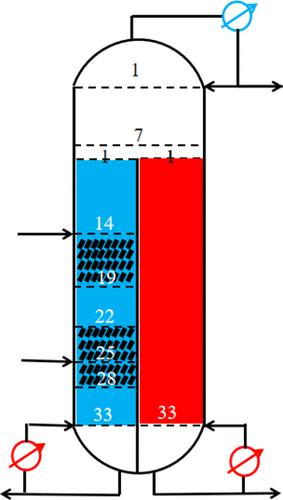当前位置:
X-MOL 学术
›
Ind. Eng. Chem. Res.
›
论文详情
Our official English website, www.x-mol.net, welcomes your feedback! (Note: you will need to create a separate account there.)
Design of Reaction Region of Reactive Dividing Wall Column Based on Cross-Wall Heat Transfer
Industrial & Engineering Chemistry Research ( IF 4.2 ) Pub Date : 2023-03-10 , DOI: 10.1021/acs.iecr.2c04358 Yuqi Hu 1, 2 , Hui Sun 1, 2 , Chunli Li 1, 2 , Honghai Wang 1, 2
Industrial & Engineering Chemistry Research ( IF 4.2 ) Pub Date : 2023-03-10 , DOI: 10.1021/acs.iecr.2c04358 Yuqi Hu 1, 2 , Hui Sun 1, 2 , Chunli Li 1, 2 , Honghai Wang 1, 2
Affiliation

|
The reactive dividing wall column (RDWC) is a column structure that couples a reactive distillation and dividing wall column. It has become a research hotspot because of its remarkable advantages in energy consumption. Most RDWCs ignore the possibility of cross-wall heat transfer. For the RDWC, the effect of reaction heat is also ignored. In this work, the reaction of methyl acetate with butanol was studied, and Aspen is used to study the effect of the reaction heat and reaction region length on the cross-wall heat transfer. The results show that compared with the RDWC with an adiabatic cross-wall, the RDWC with cross-wall heat transfer can save 3.2% energy. Cross-wall heat transfer could achieve reactants conversion of 99.4%. From the perspective of energy saving maximization, the double reaction region is set. The research results show that the RDWC with cross-wall heat transfer in the double reaction region can save 4.2% energy compared with the cross-wall insulation.
中文翻译:

基于跨壁传热的反应分隔壁塔反应区设计
反应性分隔壁塔(RDWC)是一种将反应性蒸馏和分隔壁塔耦合的塔结构。因其在能耗方面的显着优势而成为研究热点。大多数 RDWC 忽略了跨壁传热的可能性。对于RDWC,反应热的影响也被忽略了。本工作研究了乙酸甲酯与丁醇的反应,利用Aspen研究了反应热和反应区长度对跨壁传热的影响。结果表明,与带绝热跨壁的RDWC相比,带跨壁传热的RDWC可节能3.2%。跨壁传热可实现 99.4% 的反应物转化率。从节能最大化的角度出发,设置双反应区。
更新日期:2023-03-10
中文翻译:

基于跨壁传热的反应分隔壁塔反应区设计
反应性分隔壁塔(RDWC)是一种将反应性蒸馏和分隔壁塔耦合的塔结构。因其在能耗方面的显着优势而成为研究热点。大多数 RDWC 忽略了跨壁传热的可能性。对于RDWC,反应热的影响也被忽略了。本工作研究了乙酸甲酯与丁醇的反应,利用Aspen研究了反应热和反应区长度对跨壁传热的影响。结果表明,与带绝热跨壁的RDWC相比,带跨壁传热的RDWC可节能3.2%。跨壁传热可实现 99.4% 的反应物转化率。从节能最大化的角度出发,设置双反应区。



























 京公网安备 11010802027423号
京公网安备 11010802027423号